
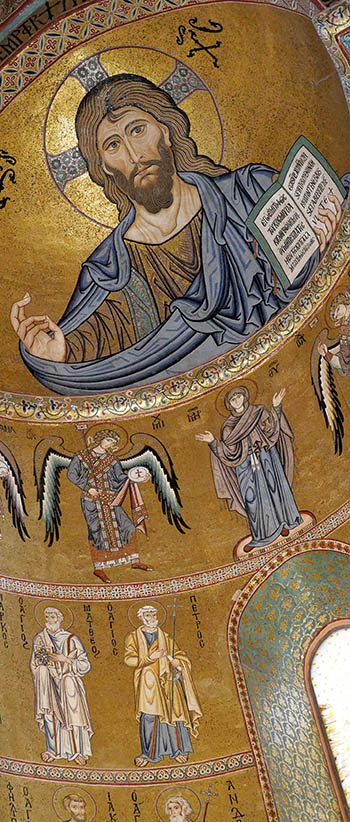
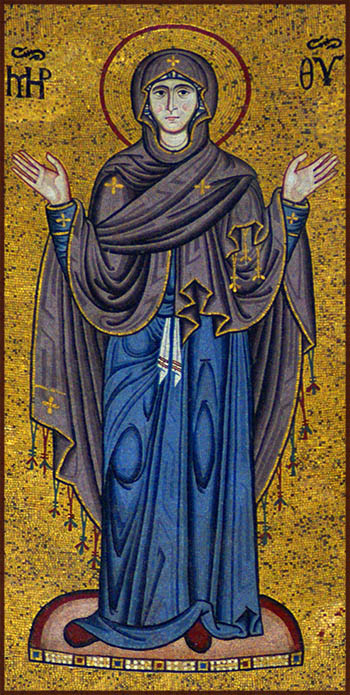
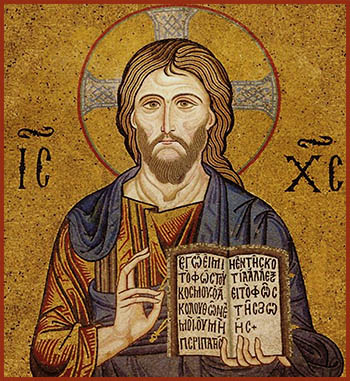
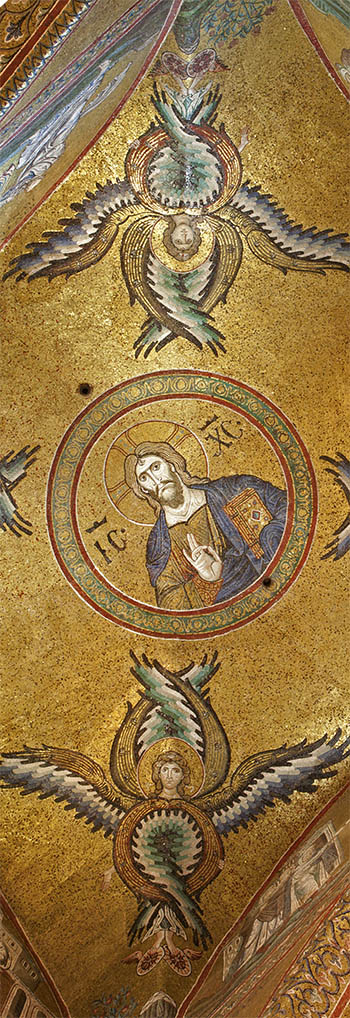
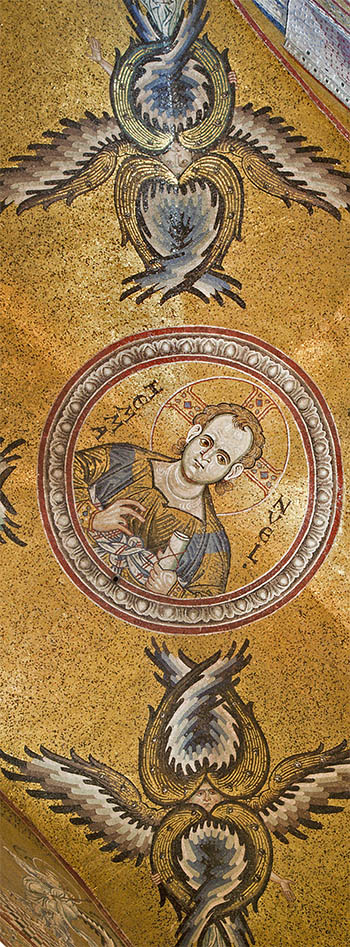


Christ Pantokrator of Monreale
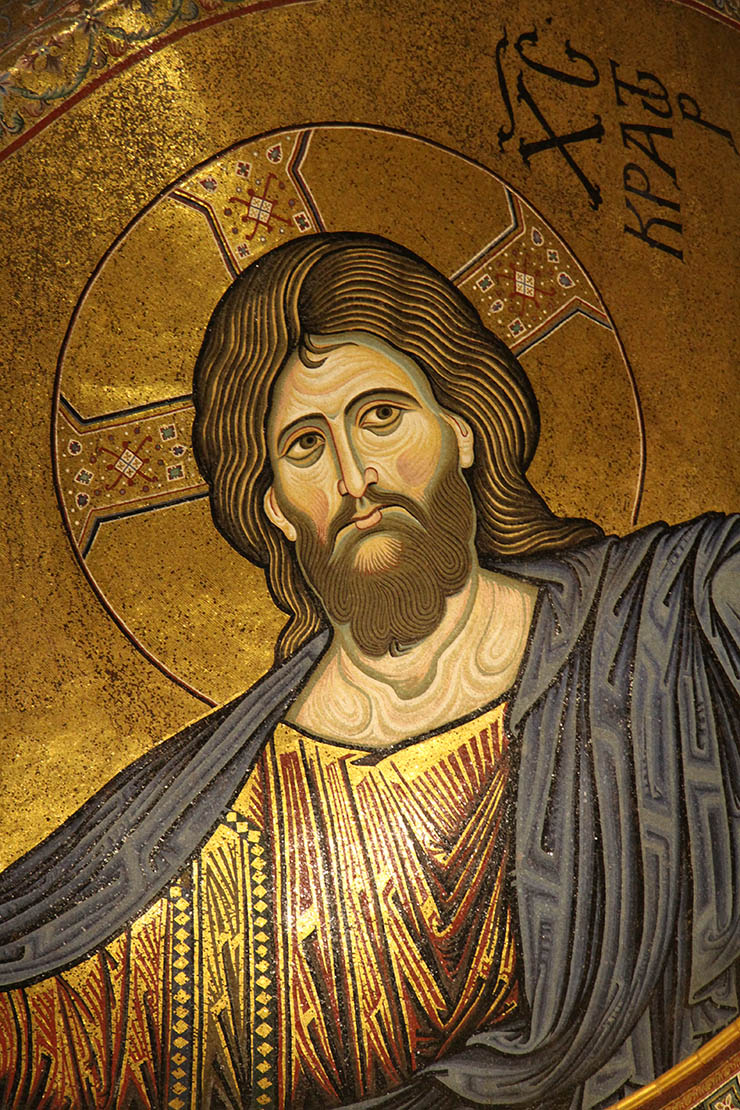 The mosaics of Monreale in Sicily were done between 1180 and 1190, 40 years after Cefalu. The church of Monreale had been founded by William II in 1174. While Cefalu was a limited program limited to the sanctuary focused on individual figures, Monreale exploded with mosaics that told stories including hundreds of figures and complex layouts. The most important mosaics were those of Christ. Even when mosaics like this one seem like they were almost copies of others every time an artist created a new Pantokrator, he attempted in his own way to combine human beauty with the divine. Byzantine mosaic artists were never simple copyists there were always new trends in art they incorporated in their work. Artists were always trying to outdo others in technique, realism or the sumptuousness of the materials.
The mosaics of Monreale in Sicily were done between 1180 and 1190, 40 years after Cefalu. The church of Monreale had been founded by William II in 1174. While Cefalu was a limited program limited to the sanctuary focused on individual figures, Monreale exploded with mosaics that told stories including hundreds of figures and complex layouts. The most important mosaics were those of Christ. Even when mosaics like this one seem like they were almost copies of others every time an artist created a new Pantokrator, he attempted in his own way to combine human beauty with the divine. Byzantine mosaic artists were never simple copyists there were always new trends in art they incorporated in their work. Artists were always trying to outdo others in technique, realism or the sumptuousness of the materials.
It was very important for images of Christ to combine his humanity and divinity in a way that was not divisible - the goal was to make an image that was a perfect man-god. What is a beautiful Christ? It changes from era to era. In 12th century Byzantium and places like Sicily where her artists did some of their finest work one of innovations seems to have been blond images of Christ like we see at Cefalu and in the Chora church. This must reflect the DNA of Normans and the Germanic folks of western Europe who took control of places like Sicily by force of arms and blond princesses who married into generations of Byzantine emperors. Although the Normans were waging all-out war on Byzantium and were hell-bent on conquering Constantinople, the Byzantines admired them for their beauty and their blondness.
If we compare the Christ Pantokrator of Cefalu with this one from Monreale there is one major difference, this one has darker hair. That's because the artist made the decision to only use one "line" of blond in the hair instead of two. Also, this Christ is less vivid because it has pale flesh lips. This was the last of the great Pantokrators to be made in Sicily and it is a swansong for the generations of Byzantine workshops and artists who brought their talent there.
Some say that the appearance of Christ Pantokrator in an apse is un-Byzantine and would never take place in Constantinople. That is proven false by the appearance of Christ Pantokrator in the apse of the Chapel of the Pammakaristos.
This Pantokrator's arms sweep out into the space of the conch of the apse; standing beneath it you really feel like Christ is enveloping you in his arms. The glittering mosaic makes one feel like you are being lifted into a golden heaven that sparkles in silence.
The church itself is impressive for its enormous marble columns and capitals. They came from Rome, these large columns with figured capitals with heads of female goddesses of Venus and Rome - used as supports between the naves of the cathedral of Monreale. The organization of the transport from the harbour of Palermo to the top of the mountain where Monreale stands is to be admired. How they were taken down and brought to Monreale with damaging them is a miracle.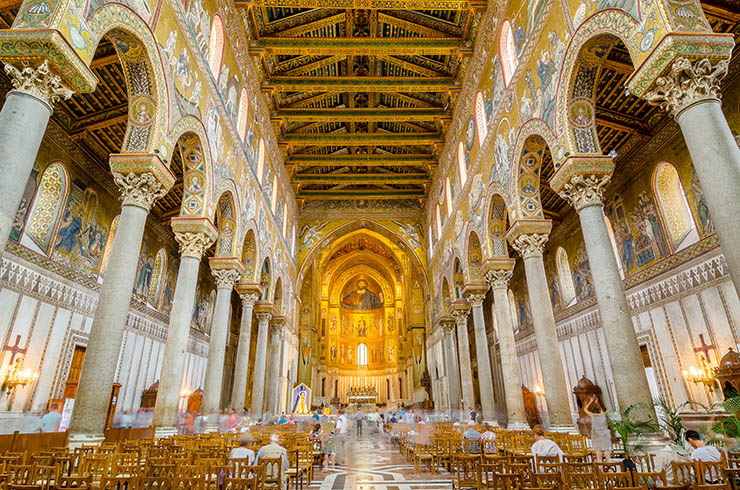
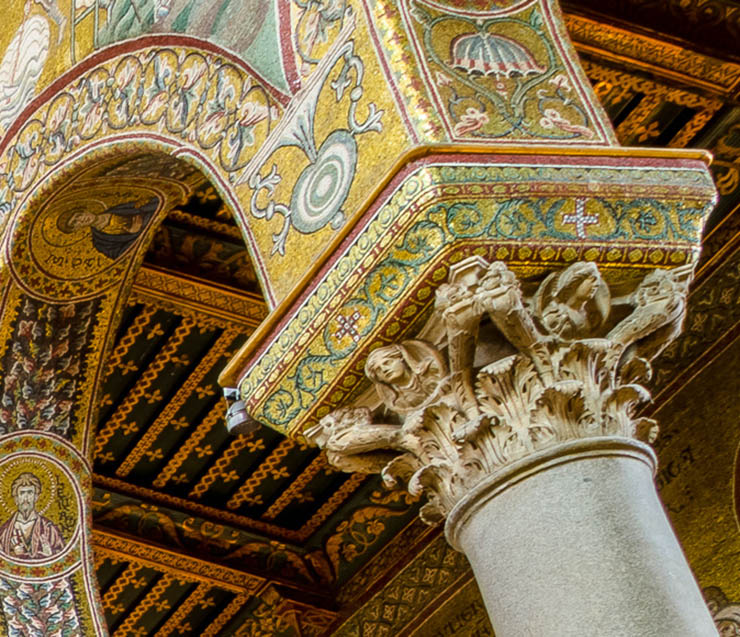
The scale of big Byzantine churches offers another challenge to the artist. The Monreale Pantokrator is set in the distant vaults of the church, far above the spectator. The artist always wanted to maintain Christ's humanity by making His image appear to human in scale to the viewer.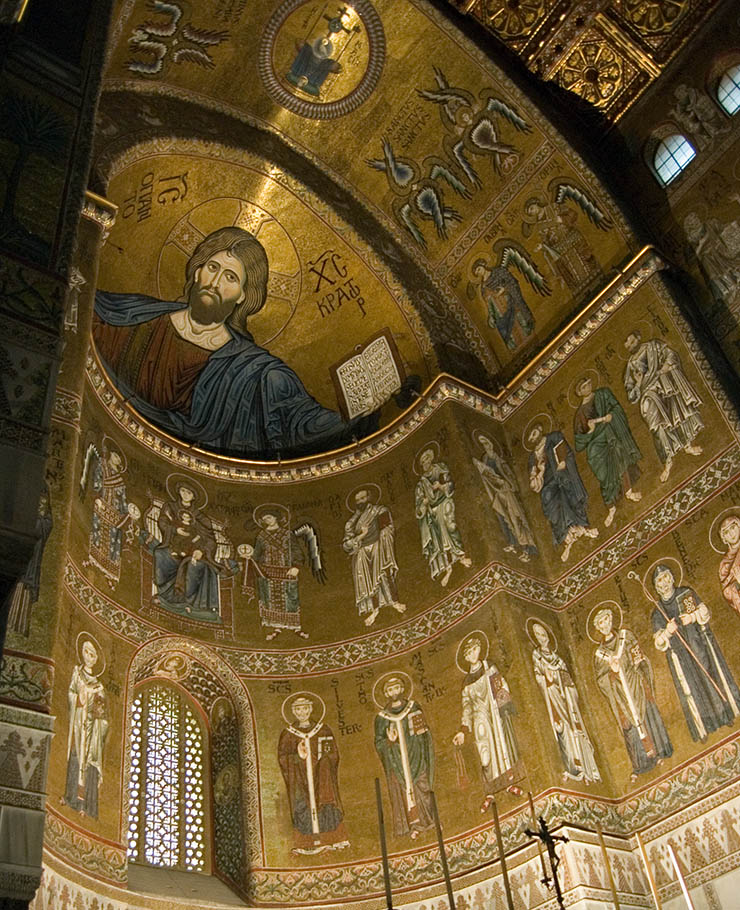 In the vault above Christ are four heavenly creatures which we might call seraphim or cherubim. They are joined by the lower order of Archangels who are chanting and adoring God in heaven. In the center of the the vault is a symbol of the Second coming of Christ. This symbol appears in the same place in the sanctuary vault of Hagia Sophia.
In the vault above Christ are four heavenly creatures which we might call seraphim or cherubim. They are joined by the lower order of Archangels who are chanting and adoring God in heaven. In the center of the the vault is a symbol of the Second coming of Christ. This symbol appears in the same place in the sanctuary vault of Hagia Sophia.
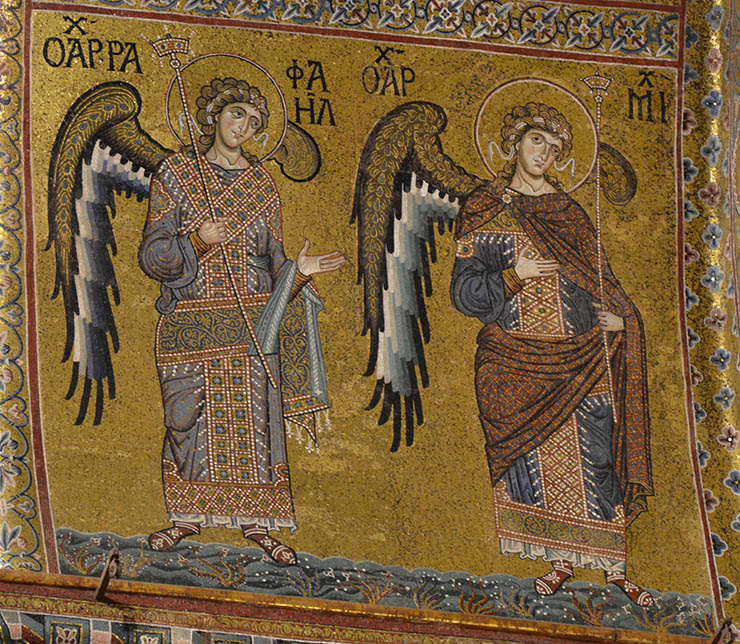
Below on the wall of the apse we see an enthroned Theotokos attended by two more archangels. The Virgin sits on a lyre-back throne hung with silk and set with silk cushions.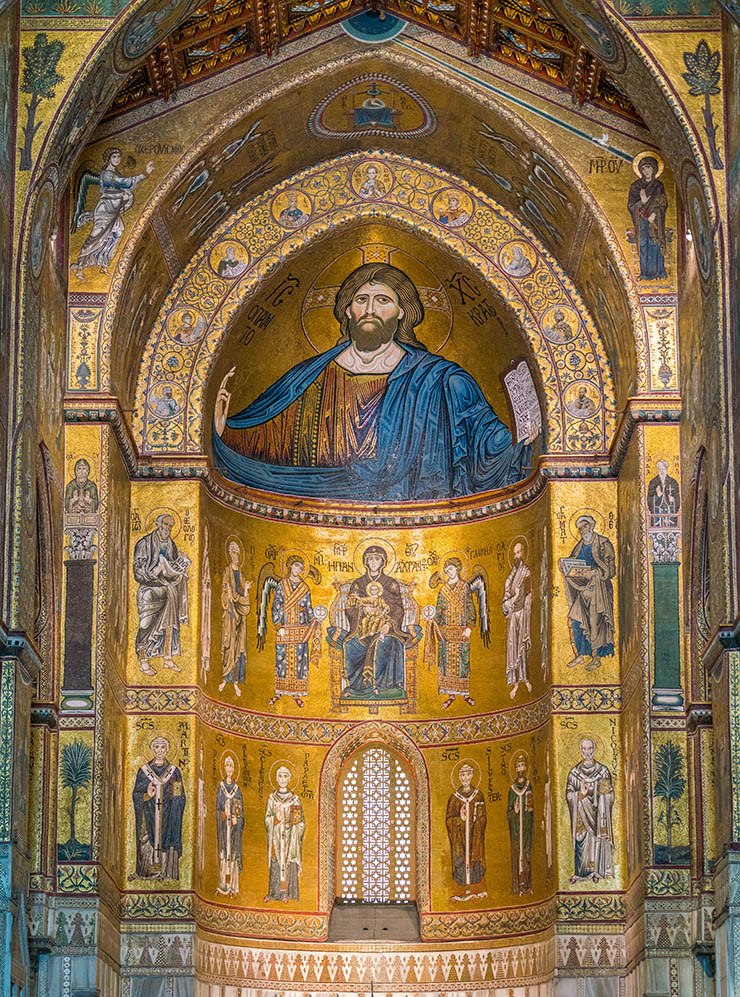 "While competing directly against the Byzantine emperors in conquest, King Roger II (1095-1154), his son William I (1120-1166), and Roger's grandson William II (1154-1189) nevertheless admired and emulated the Byzantines both in court ceremonies and in the decoration of their churches, especially in the vast expanses and extensive cycles of mosaics. In addition to importing Greek mosaicists, they brought Byzantine silk weavers to Sicily, where they set up their own workshops and produced fabrics that not only resembled Byzantine patterned silks but matched them in quality"-
"While competing directly against the Byzantine emperors in conquest, King Roger II (1095-1154), his son William I (1120-1166), and Roger's grandson William II (1154-1189) nevertheless admired and emulated the Byzantines both in court ceremonies and in the decoration of their churches, especially in the vast expanses and extensive cycles of mosaics. In addition to importing Greek mosaicists, they brought Byzantine silk weavers to Sicily, where they set up their own workshops and produced fabrics that not only resembled Byzantine patterned silks but matched them in quality"-
The Glory of Byzantium, 1997 Published by the Metropolitan Museum of Art, New York

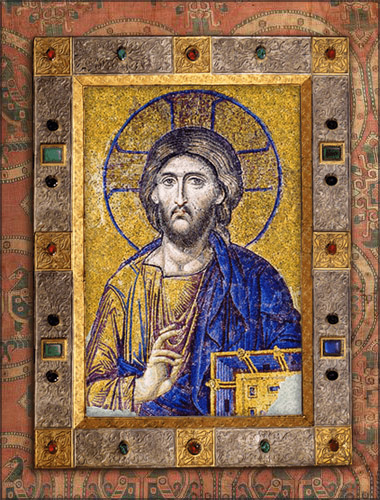


 click here for icons of christ
click here for icons of christ click here for icons of the theotokos
click here for icons of the theotokos click here for icons of angels
click here for icons of angels click here for icons of saints
click here for icons of saints








